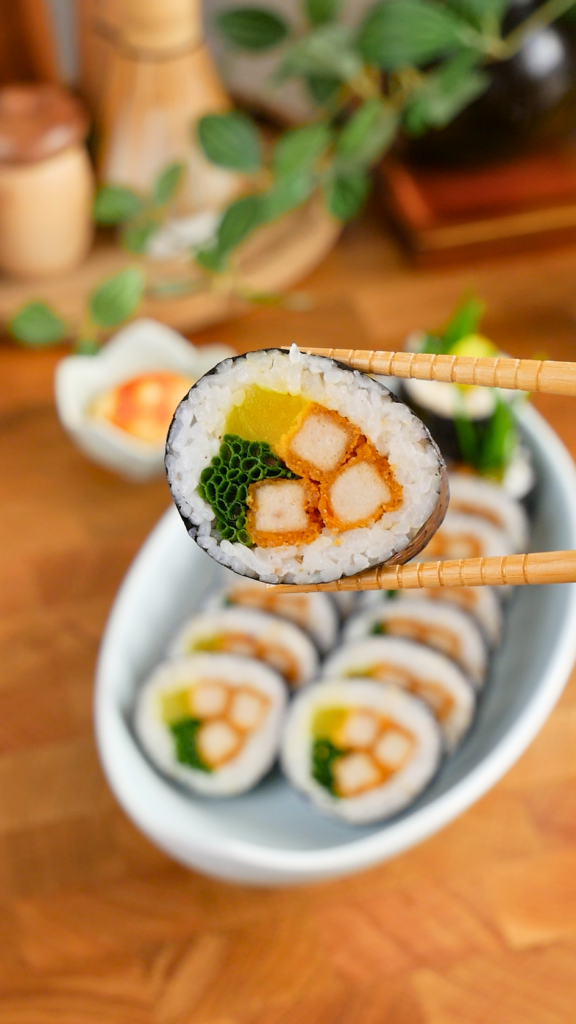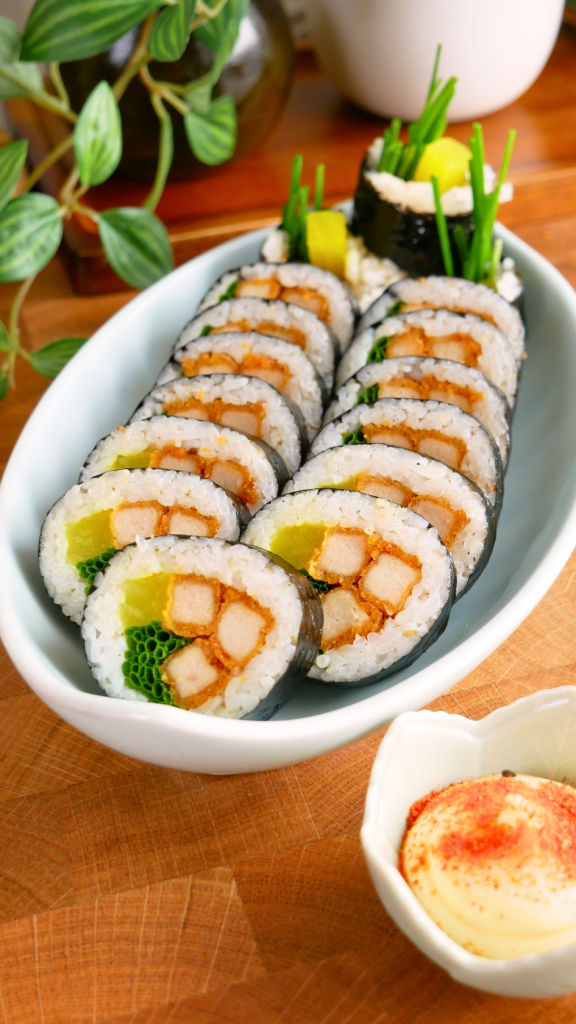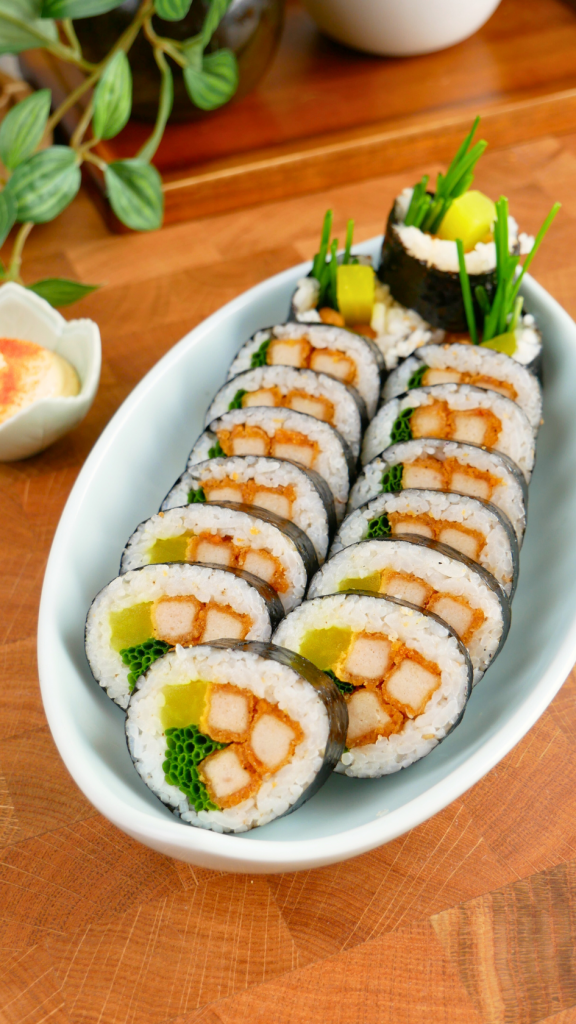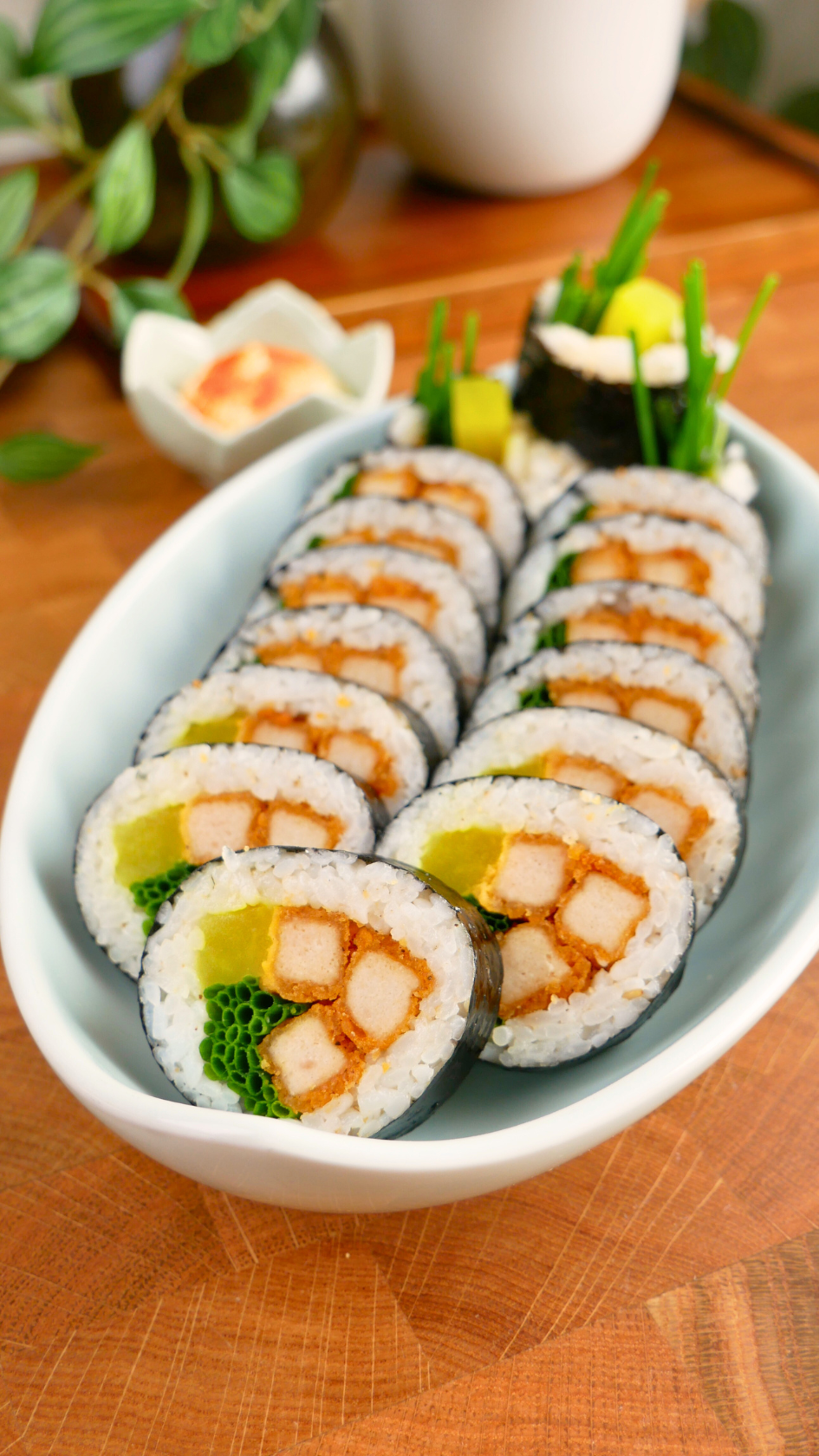Chicken kimbap is an East meets West fusion of a Korean classic favorite. It’s filled with chicken fries, Korean yellow pickled radish (or ‘danmuji‘ in Korean), and chives for a balanced yet delicious bite!
When I was in middle school and high school, there weren’t too many school lunch options to choose from. It’d usually be a daily rotation of sloppy joe, pizza, and chicken tenders… lol.. but my favorite lunch out of the three would be the chicken tenders! They were served with a burger bun on the side so I’d sandwich the tendies in between the bread and enjoy it with a side of mayo.
The familiar taste of chicken tenders definitely comes through in this kimbap so if you grew up eating chicken tenders at home or school like I did, you’re going to enjoy this. And even if you didn’t, I’m almost certain that you’ll still enjoy it!

Why you’ll love this recipe
The simplicity yet deliciousness of this recipe is a blend of a Western classic – chicken tenders – and Korean ingredients. The flavors and textures of the savory chicken, tangy & crunchy Korean yellow pickled radish, and fresh chives wrapped in seasoned rice and seaweed are a unique combination – but one that’s irresistibly tasty. As an ode to my childhood nostalgia, I’ve served this kimbap with a side of mayo but you can enjoy it at is or with a dipping sauce that you like including honey mustard, spicy mayo, or sweet chili sauce.
While I added Korean pickled radish and chives to complement the chicken, you’re welcome to substitute or add other ingredients that you like! What I love about kimbap is the customizability of the dish – you can essentially fill kimbap with anything! It’s a great way to indulge in the flavors that you enjoy as a quick and nourishing lunch or as a meal for when you’re on the go.

Chicken Kimbap Ingredients & Substitutions
Cooked rice: when making kimbap, you want to use short-grain or medium-grain rice. The high starch content of these rice varieties makes them sticky and allows them to hold shape. I don’t recommend long-grain rice like Jasmine or Basmati – they are not starchy enough and can fall apart.
Sesame oil – adds a bold, nutty, and rich flavor to the rice. I like using the Kadoya brand.
Toasted sesame seeds: for some crunch and nuttiness. Toasted sesame seeds are a must – you get a more intense nutty flavor! If you have raw sesame seeds, toast them in a pan over low heat until golden brown.
Salt: seasoning in layers will make the kimbap taste even better. The rice should NOT be heavily salted or seasoned.
Roasted seaweed sheet: the vessel that holds the kimbap together! You want to use unsalted roasted seaweed sheets.
Chicken Filling Ingredients & Substitutions
Frozen chicken fries: to save time, I used Tyson Any’tizers chicken fries, which are the perfect size for this dish. You can use any type of frozen chicken brand, make your own at home, or even use leftover rotisserie chicken!
Korean yellow pickled radish: also called ‘danmuji‘ in Korean, this is a yellow pickled radish that can be found at your local Asian market. They’re usually sold in a long cylindrical shape or pre-sliced. You’ll notice them right away because they have a highlighter yellow color.
Chives: I used about 15 chives per kimbap but you can use less or more depending on your preferences. Chives can also be substituted with scallions or your favorite fresh herbs.
Dipping Sauce (Optional)
Kewpie mayo: I exclusively use Japanese Kewpie mayo for all my recipes but you can also use regular mayo.
Chili powder: I used nanami togarashi, which is a Japanese chili powder, but any chili powder would work including gochugaru (Korean red chili flakes), cayenne, or paprika.

How to Prepare Chicken Kimbap
Step 1: Make the chicken fries
Preheat oven to 400F (205C).
Place frozen chicken fries on a sheet tray lined with parchment paper. Be sure to leave space in between each piece. Bake for 15 minutes or cook based on package instructions then remove from the oven and set aside.
Step 2: Season the rice
In a medium mixing bowl, combine cooked rice, sesame oil, sesame seeds, and salt. Mix well.
Step 3: Assemble the kimbap
Place a sheet of roasted seaweed (rigid side up, smooth side down) on a bamboo rolling mat. Add 1/3 of the rice mixture onto the seaweed. Wet your fingers then spread the rice evenly on the seaweed 3/4 of the way to the top.
Layer on the chicken fries, pickled radish, and chives in the center of the rice. To roll the kimbap, lift the bamboo rolling mat then roll, tuck, and squeeze to form a kimbap. You want to make sure the kimbap is nice and tight.
Step 4: Brush with sesame oil
Brush the top of the rolled kimbap with a layer of sesame oil.
Step 5: Slice and serve!
Slice into 1/2 to 1-inch pieces and serve with the optional dipping sauce.
Preparation Tips for Chicken Kimbap
- Short-grain or medium-grain rice is a must! Don’t use long-grain rice – they are not starchy or sticky enough.
- While I used frozen chicken fries to save time, you can definitely make the chicken at home from scratch or use leftover rotisserie chicken. The chicken doesn’t necessarily have to be breaded – as long as it’s seasoned, it’ll work.
- To roll the kimbap, you’ll need a bamboo rolling mat. This will make kimbap rolling much easier and help it stay nice and tight.
- One problem that people ask me is how I slice my kimbap so effortlessly. The answer is simple – you need a sharp knife! The sharper the knife, the easier it will be to cut. What you don’t want to do is press the knife against the kimbap without cutting all the way. This will make a dent in the kimbap and may cause the filling to spill out at the ends. When cutting with a sharp knife, make sure to cut down fast with a little bit of force.
Frequently Asked Questions
What is kimbap made of?
Kimbap is a popular Korean street food that’s made with a variety of cooked fillings wrapped in rice and roasted seaweed. Some of the more popular kimbap fillings include bulgogi, shrimp tempura, and my personal favorite – Spicy Tuna Kimbap! The best part about kimbap is that the filling can be customized based on anything you like. It’s a dish that you can truly make your own, so you can have fun experimenting with ingredients and flavor combinations that you like.
What is chicken kimbap made of?
As the name suggests, chicken kimbap is made with a chicken filling! For this recipe, I used frozen chicken fries, Korean yellow pickled radish called ‘danmuji’, and chives for freshness. As mentioned above, the filling can be adjusted based on ingredients and flavors that you enjoy. You can use frozen chicken fries like I did or you can make your own from scratch! If you have leftover rotisserie chicken, that would be a great alternative too.
Is kimbap and sushi the same?
People often confuse kimbap with sushi due to the similarities in their aesthetic. However, they are not the same thing and can be distinguished by two factors. First, the rice for kimbap is usually seasoned with sesame oil, sesame seeds, and salt whereas sushi rice is mixed with rice vinegar, sugar, and salt. Based on the seasoning of the rice, you can already tell that the flavors are vastly different. Second, the filling for kimbap is always cooked as opposed to the fillings for sushi, which is usually raw seafood. One last feature that distinguishes kimbap from sushi is that the seaweed is always on the outer layer for kimbap whereas for sushi, the rice is usually the outer layer.
Can I make Chicken Kimbap in advance?
Yes, absolutely! Kimbap is one of those meals that you can prepare ahead of time, which makes it a great on-the-go meal. If you plan on making it in advance, I recommend consuming it within 2 hours or keeping it chilled and then bringing it to room temperature before enjoying it. When I’m on the road or hiking, I always make sure to bring an ice pack to keep my kimbap chilled if I’m anticipating a long trip.
How long can I store Chicken Kimbap?
Chicken kimbap or any kimbap should be stored in an airtight container or tightly wrapped in saran wrap in the fridge if not consumed within 2 hours. They can typically last for 2 to 3 days however, be sure to always do a smell check in case of any spoilage.
Looking for more easy and delicious Korean-inspired recipes?
- Bibim Myeon – or Korean Spicy Cold Noodles is a spicy, sweet, and tangy cold noodle dish that’s perfect for when you’re craving a light, refreshing, and nourishing meal!
- Marinated Salmon Sashimi – this is a Korean raw marinated salmon sashimi dish called ‘yeoneojang‘. It’s made with raw salmon that has been cured in a rich and savory soy marinade – perfect with a bowl of rice!
- Boiled Pork Belly – better known as ‘bossam‘, it is a classic comfort dish made of tender succulent pork belly that is boiled in various seasonings and aromatics. It’s enjoyed with an assortment of side dishes and sauces wrapped in cabbage.
- Korean Hot Dog – Korean hot dogs or corn dogs are a popular Korean street food with a chewy and crispy exterior that is the perfect coating for the juicy hot dog and cheesy center. It’s a great appetizer or snack!
- Japchae Dumplings – If you like japchae and dumplings, this recipe is for you! These are also great for freezing so you can make a batch to freeze and enjoy them whenever you want!

Chicken Kimbap Recipe
Ingredients
- 2 1/2 cups cooked rice short-grain or medium-grain
- 2 tsp sesame oil plus more for garnish
- 1 tsp sesame seeds
- 1/4 tsp salt
- 3 roasted seaweed sheet
Filling
- 18 pcs frozen chicken fries like Tyson Any'tizers
- 3 slice Korean yellow pickled radish called 'danmuji'
- 1 bunch chives about 15 per kimbap
Dipping Sauce (Optional)
- 2 tbsp Kewpie mayo
- 1/2 tsp chili powder
Instructions
- Preheat oven to 400F (205C).
- Place frozen chicken fries on a sheet tray lined with parchment paper. Be sure to leave space in between each piece. Bake for 15 minutes or cook based on package instructions then remove from the oven and set aside.
- In a medium mixing bowl, combine cooked rice, sesame oil, sesame seeds, and salt. Mix well.
- Place a sheet of roasted seaweed (rigid side up, smooth side down) on a bamboo rolling mat. Add 1/3 of the rice mixture onto the seaweed. Wet your fingers then spread the rice evenly on the seaweed 3/4 of the way to the top.
- Layer on the chicken fries, pickled radish, and chives in the center of the rice. To roll the kimbap, lift the bamboo rolling mat then roll, tuck, and squeeze to form a kimbap. You want to make sure the kimbap is nice and tight.
- Brush the top of the rolled kimbap with a layer of sesame oil.
- Slice into 1/2 to 1 inch pieces and serve with the optional dipping sauce.
